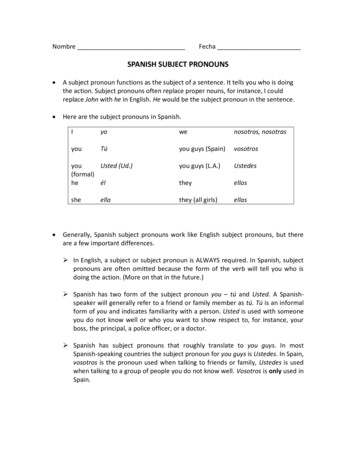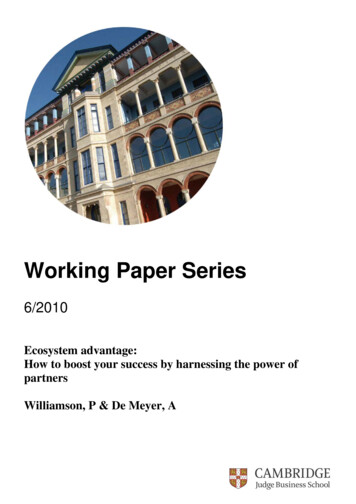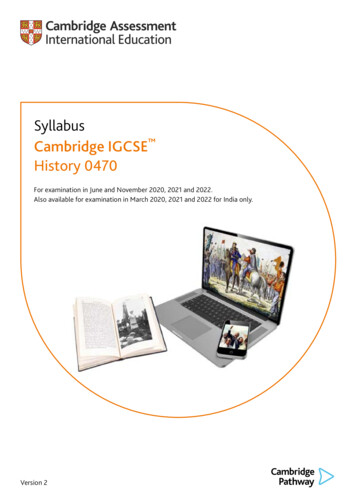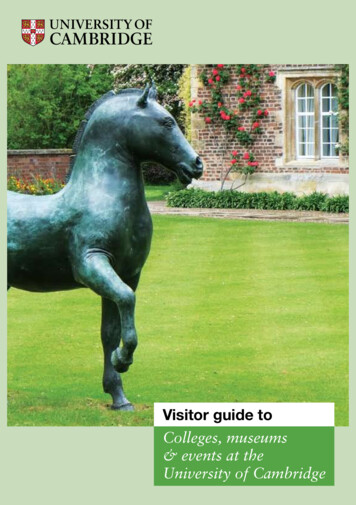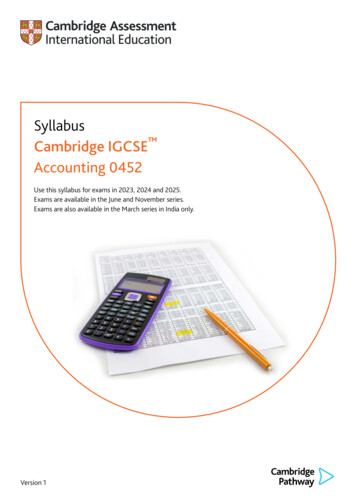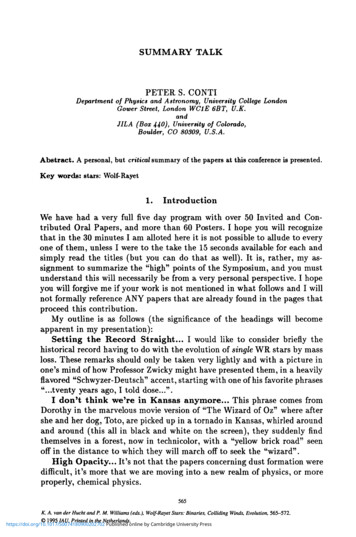
Transcription
S U M M A R Y TALKP E T E R S. C O N T IDepartmentof Physics and Astronomy,University CollegeGower Street, London WClE 6BT,U.K.andJILA (Box 44Ο), University of Colorado,Boulder, CO 80309,U.S.A.LondonA b s t r a c t . A personal, but critical summary of the papers at this conference is presented.K e y w o r d s : stars: Wolf-Rayet1.IntroductionWe have had a very full five day program with over 50 Invited and Contributed Oral Papers, and more t h a n 60 Posters. I hope you will recognizet h a t in the 30 minutes I am alloted here it is not possible to allude to everyone of them, unless I were t o the take the 15 seconds available for each andsimply read the titles (but you can do t h a t as well). It is, rather, my assignment t o summarize the "high" points of the Symposium, and you mustunderstand this will necessarily be from a very personal perspective. I hopeyou will forgive me if your work is not mentioned in what follows and I willnot formally reference ANY papers t h a t are already found in the pages t h a tproceed this contribution.My outline is as follows (the significance of the headings will becomeapparent in my presentation):S e t t i n g t h e R e c o r d S t r a i g h t . . . I would like t o consider briefly thehistorical record having to do with the evolution of single W R stars by massloss. These remarks should only be taken very lightly and with a picture inone's mind of how Professor Zwicky might have presented them, in a heavilyflavored "Schwyzer-Deutsch" accent, starting with one of his favorite phrases".tventy years ago, I told dose.".I d o n ' t t h i n k w e ' r e in K a n s a s a n y m o r e . . . This phrase comes fromDorothy in the marvelous movie version of "The Wizard of Oz" where aftershe and her dog, Toto, are picked up in a tornado in Kansas, whirled aroundand around (this all in black and white on the screen), they suddenly findthemselves in a forest, now in technicolor, with a "yellow brick road" seenoff in the distance t o which they will march off to seek the "wizard".H i g h O p a c i t y . . . It's not t h a t the papers concerning dust formation weredifficult, it's more t h a t we are moving into a new realm of physics, or moreproperly, chemical physics.565K. A. van der Hucht and P. M. Williams (eds.), Wolf-Rayet Stars: Binaries, Colliding Winds, Evolution, 565-572. 1995 IAU. Printed in the 702 Published online by Cambridge University Press
566P.S. CONTIA r e w e h a v i n g fun y e t . . . ? You and your spouse are on a lengthy cartrip with your two sub-teen age children in the back seat. They have beenprodding and poking each other, and fighting, for a good part of the day.You have seen many tourist sites and there are a few still t o go, along withquite some more miles t o drive. Your spouse turns around to the back andasks "Are we having fun yet?"It t a k e s t w o t o t a n g o . . . A popular American phrase, this has t o dohere with binary W R stars.T h e d o g ( s ) t h a t did not bark. In one of the Sherlock Holmes mysteries, a critical clue is ultimately provided by the realization t h a t at a certaintime and in a certain place a dog did not bark.A r e w e t h e r e y e t ? . . . This is the same car and occupants as above, butit is uttered by one of the two kids about 30 minutes after the trip begins.2.S e t t i n g t h e record s t r a i g h t . . .I am particularly pleased t o see so many new faces in this audience; clearly weare working in an exciting and burgening field of astrophysics. Drs. Niemela,Seggewiss, Smith and myself are the only "remnants" of the Buenos AiresIAU Symposium No. 49 (which took place in 1971) who are still with youtoday. A subsequent quarter century of work has defined the appearanceof W R stars as a class of objects in a reasonably well understood phase ofmassive star evolution t h a t we know and love so well.IAU Symposium No. 49 ended with (nearly) all of us agreeing t h a t "all"W R stars were binaries, and their anomalous masses, luminosities, and compositions could readily be understood as the effect of close binary interactions and Roche Lobe overflow leaving the remnants of Η-burning, or Heburning, products on the surface of the initially more massive star. Thisconclusion rested upon an assumption, t h a t all W R stars were binaries, andmade a prediction; namely, t h a t the companions of W R stars should showanomalous composition from the mass overflow of the helium burning star.I had already begun thinking and working in the area of O-type stars; Iwas especially concerned with the question "what does a normal 0 star looklike" (so as to address the prediction above). I was also concerned with thepresence of single massive O-type stars. W h a t do they evolve into? Was itindeed true t h a t all W R stars were binaries?(Now, in "Schwyzer-Deutsch" accent) I believe the first paper addressingthese issues was Conti (1976). Here was laid out the idea of single starevolution of the most massive O-type stars to the W R stage by stellar windmass loss (and a "P-Cygni" phase). This later became known as the "Conti"scenario (Maeder 1983), so t h a t while it is my scenario, I am not responsiblefor its name. The original paper makes no reference to a number for thelower mass limit of single star W R evolution, except to hint at its probablehttps://doi.org/10.1017/S0074180900202702 Published online by Cambridge University Press
567SUMMARY TALKexistence. I have spent time on this today since some authors have persistedin denigrating "my" scenario as only applying to stars so massive as t o notexist. My personal advice t o all of you: read the literature!It appears t h a t most W R stars get to their advanced evolutionary stateby previous episodes of mass loss during the 0 star and LBV phases. Closebinary stars may proceed by the R L O F channel. Standard Models for suchsingle star evolution are sufficiently advanced as t o make testable predictions about W R / O star ratios and W N / W C / W O type populations, in roughagreement with observations of stars in various galaxy environments. Twoindependent proposals concerning the precise "channels" taken by singlestars were given, but, unfortunately, differed in their details.3.I d o n ' t t h i n k w e ' r e in K a n s a s a n y m o r e . . .Standard Models for the stellar winds were presented for the first time fouryears ago at the Bali IAU Symposium No. 143 and were considered a majoradvance in our understanding of the emergent spectra of W R stars. Well,we are now going t o have to put aside these playful things and move forward again! We have heard discussion of some simple modifications to theatmospheric and wind models which might be needed:i. Velocity law β 1 (perhaps even increasing outwards).it. More complete line identifications and improved relevant atomic physicsparameters for the abundant elements, particularly iron,tit. Non-LTE line blanketing, taking full account of line spacing.iv. T h e effects of rotation and asymetrical structure as it might affect theradiation field and stellar spectrum (density enhancement model).These advances can be done with current knowledge and computer technology, but lots of work! We also find t h a t New Physics and much more effortwill be needed to address such problems as:v. Clumping and inhomogeneities in the stellar winds.vi. Effect of shocks on the ionization balance; production of the X-ray emission in the winds.vit. Physically consistent radiative hydrodynamics treatment of the outflow,which is probably not smooth.viii. A newly proposed Bowen Mechanism process for the interaction between an FeVI line and the λ 303 Hell transition, which I will call a "SwissCheese" model (it looks good, it smells right, it tastes great, but it's stillfull of holes).It is already clear t h a t a combined evolution/wind model approach willbe necessary and the first steps along this path are already being taken.T h e Standard Models give line predictions of some lines in some stars inagreement with the observations. We need to use all lines in all stars! Givenall this, how trustworthy are the current predictions of luminosity, T ff, andehttps://doi.org/10.1017/S0074180900202702 Published online by Cambridge University Press
P.S. CONTI568mass loss rate from the Standard Models? I would urge caution in settingtoo great a store, as yet, on these numbers. Furthermore, why do the W Nstar models imply bimodal behavior (" strong" and "weak-lined") while theobservations (e.g., continuum slopes) do no(lExtensive wavelength coverage and analysis of many (single) W R starssuggests a power law continuum longward of the R — J peak, but with a(log-log) slope nearer t o - 3 , rather than the canonical R — J limit o f - 4 , andslightly different from star to star.4.High opacity.Circumstellar dust is observed around most WCL stars, but not all. Whyis this? Several W C stars have episodic dust formation. At least some ofthese are binaries, which presumably influences the event. Are all of theepisodic dust emitters binaries? If not, what drives their activity? There havebeen more questions raised than answers given. Dust seems to be associatedexclusively with W C stars, presumably because of their high carbon content.W h y don't we observe silicate based dust in W N stars?We heard and saw much about the variable dust activity in WR140; isthis object a freak or a prototype!A new and exciting chemical kinetic approach to the formation of dustsurrounding W C stars has been presented. The factor 1 0 discrepancy inthe required density might be regarded as excessive for any theory but itmight point the way t o deficiencies in our knowledge of the stellar winds.For example, the "persistent" dust formation might require clumping; the"episodic" events might require a disk to be present, possibly a n a t u r a lconsequence of a binary interaction. Is "smog" present? In other words,does the radiation field play any role in the dust formation process?35.A r e w e h a v i n g fun y e t ? . . .The answer t o this is yes! I was most impressed with some of the really "fun"observations we have heard about. In particular, the polarimetry, only recently begun in any systematic manner, can now give us unique informationfor b o t h single stars and binary systems. For single stars one finds caseswhere the wind is:i. Spherical and homogeneous.ii. Spherical and mhomogeneous.Hi. j4spherical and mhomogeneous.iv. T h e Aspherical and homogeneous case has not been observed.Additional observations are critically needed to get information on the statistics of these cases. For example, is there a spectral subtype dependence?W h a t is the quantitative degree of asphericity and 2702 Published online by Cambridge University Press
SUMMARY TALK569In a completely different area, we heard and saw the use of ring nebulaeas tracers of the properties of their exciting W R stars. One may use thenebulosity t o :t. Derive a chemical composition consistent with the predictions of the evolution models.it. Estimate the T ff of the exciting star.tit. Infer an initial asymmetry to the stellar wind in several cases.iv. Deduce the presence of collapsed companions (but see 7).Several papers addressed the connection between W R phenomena in Symbiotic Stars and in the Central Stars of Planetary Nebulae as compared t oour nominal Population I stars. The former objects are far removed in anevolutionary sense, yet showing somewhat similar physics. We can certainlyeach learn from each other in our studies of these complicated systems.A good part of the meeting was devoted to the relatively new topics ofhigh energy astrophysics, both theory and observation. Much of this involvesbinaries.e6.It t a k e s t w o t o t a n g o . . .Binaries provide fundamental d a t a on masses t h a t can be obtained in noother direct fashion. This work is fraught with pitfalls, but the potentialpayoff in our understanding of the stellar parameters of W R stars is enormous. An important assumption, one not easily amenable to confirmation,is t h a t binary and single stars with otherwise identical spectroscopic characteristics will have similar masses. We can only hope this is true.As contrasted to past meetings, there was little presented here concerningt h e evolution of binary W R systems, aside from the useful contribution ofmodeling with half the mass lost from the system, and half gained by thesecondary. Is the concept of R L O F even viable in the presence of strongstellar winds? Perhaps one should a t t e m p t R L O F modeling with all themass lost from the system. This extreme case might better mimic whathappens in real stars. Note t h a t such a "sudden" mass loss is distinct fromwhat is currently being played out in single star models of evolution! Myguess is t h a t the results might prove significantly distinct from what hasbeen found in previous cases. Binary interactions clearly play some role inmassive star evolution, even if they do not dominate the statistics.Detailed examination of several close binary W R plus O-type systemsgives one information on the period changes and mass loss rates. The latternumbers are typically a factor two lower than those inferred from spectroscopic analyses or considerations of the electron densities. The interpretations is t h a t the stellar winds are not uniform, but clumpy, a conclusion t h a tappears in several other guises during this meeting.There was a considerable effort devoted to the physics of interacting bi-https://doi.org/10.1017/S0074180900202702 Published online by Cambridge University Press
570P.S. CONTIFig. 1.Schematic View of W R plus O-type Binary Systemsnaries at this conference and, for me, a very exciting aspect was the number of astrophysicists presenting results on this topic. I show in Figure 1 aschematic view of the shock cone shaped cavity t h a t represents the framework for colliding winds, with consequences for high energy astrophysics.Let me mention (only) a few of these:i. Strong, periodic, phase dependent variable X-ray signature in 7 Vel.it. Periodic, phase dependent, spectroscopic variability in such objects asCQ Cep, CX Cep, etc.Hi. Use of colliding wind phenomena to give information on stellar windinhomogeneities (clumping).iv. 2D, 3D modeling of the hydrodynamics.v. T h e necessity of a magnetic field in at least one binary, due t o innovativeutilization of the Razin Effect.We heard much about HD 193793: e.g., the multi-wavelength, 2 Published online by Cambridge University Press
SUMMARY TALK571observations, the suggestion of disc morphology but not aligned with theorbit. How would such a binary system form with such a long period, highlyeccentric orbit, misaligned axes? Is this object a freak or a prototype!7.T h e d o g ( s ) t h a t did not bark.A question t h a t had been with us for quite some time was " W h a t is thedriving mechanism in W R stars?" This had come about because of the verystrong winds and the implied inordinate momentum forces needed for radiative processes t o be acting alone. "Other" physical driving mechanisms havebeen looked for, without success, for well over 3 decades. At this meetingwe heard: "It's not a momentum problem, it's an opacity problem!", and wewere additionally presented with a new ("Swiss Cheese") model addressingt h a t issue. Of course, difficulties remain, but my personal feeling is t h a t thislongstanding non-issue should finally be laid to rest.Both radial and non-radial pulsations have been searched for (see above)for literally decades and have not yet been found for certain in the d a t a .Could this be another case of a dog not barking? If these phenomena playany role, why are they so difficult to observe? I must mention the 6.8 hourperiod found for W R 4 6 by two independent investigators. W h a t does thisvery short period represent? Is this exceptional star ( W N E plus strong 0 VIlines) really an initially massive Population I object?W R plus compact companions ("cc") have been predicted on evolutionarygrounds for two decades but (until recently?) not identified. Many candidateshave been put forward: EZ CMa was the first and the "easiest" case. Theproblem with all these objects has been the lack of a strong X-ray signatureand the absence of the "Hatchett-McCray"effect (periodic variability in thestrong stellar wind lines due to an ionization cavity from the cc). The absenceof any observations matching these predictions has, in the past, been "handwaved" away with what I feel is completely inadequate physics. We now havet h e example of Cyg X-3 put forward as the "missing link", as the newlydetected stellar companion has strong helium and nitrogen emission lines inthe near-IR just like classical WN stars. In the spirit of "If it walks like aduck, quacks like a duck, and associates with other ducks", I will call CygX-3 a duck. (Of course, geese also have superficially similar properties.)For the "ducks": Cyg X-3 is the missing link; then all the other W R c ccandidates fail since they have no strong X-rays nor Hatchett-McCray Effect, which Cyg X-3 certainly shows. For the "geese": Cyg X-3 is not themissing link, but rather a low mass Population II object masquerading asPopulation I. Then the other proposed W R c c remain viable candidates.But, if the Cyg X-3 system is not a "duck", then what is it? Amid all thequacking and fluttering of feathers, there was no consensus at this conference on the nature of the companion (but my personal bet is still for thehttps://doi.org/10.1017/S0074180900202702 Published online by Cambridge University Press
572P.S. CONTI"duck").8.Are we there yet?.Well no, we still have a great deal to do. At the risk of subsequently lookingfoolish, I would single out several questions which struck me as particularlyin need of work and which might have the most significant payoff:i. W h a t is the place of mixing in massive star evolution (this refers also t othe 0 star phase)? Better understanding of the LBV phenomena and itsepisodic mass loss for use in modeling massive single star evolution wouldbe very helpful.ii. How important are non-homogeneities and asphericities in the winds ofW R stars? How will the addition of these parameters t o the models shapeour understanding of the overall properties of the stellar winds, and, ultimately, our knowledge of the underlying star?Hi. W h a t role do discs play in the physics of single stars? They seem tobe present in some, but (curiously) not all, objects. Is their role major inshaping the emitted spectrum or is it merely a perturbation on the radiativedriving forces? Why should single W R stars have discs anyhow?iv. How relevant is the 2D modeling of colliding winds as indicated schematically by Fig. 1? Do we need to proceed immediately to 3D? Wind compression models in binary systems are in their infancy, but very exciting physicsis already resulting.DESIDERATA for the future include:i. Multiwavelength coverage, and extensive observational programs aimedat fully understanding the nature of the variability in at least a few single,and, of course, binary stars.ii. More detailed modeling and improved physically consistent theory of thestellar winds.Hi. Finally, let us look forward to another nice IAU Symposium in a pleasantvenue t o report on our collective and collaborative efforts concerning theseenigmatic but delightful stars in the next few years!AcknowledgementsI would like t o personally acknowledge the hospitality of Dr. Allan Willis ofUniversity College London where this paper was written.ReferencesConti, P.S. 1976, Mem. Soc. Roy. des SciencesMaeder, A. 1983, A&A 1 2 0 , 113de Liege, sixth série, t o m e I X , 193https://doi.org/10.1017/S0074180900202702 Published online by Cambridge University Press
SUMMARY TALK PETER S. CONTI Department of Physics and Astronomy, University College London Gower Street, London WClE 6BT, U.K. and JILA (Box 44Ο), University of Colorado, Boulder, CO 80309, U.S.A. Abstract. A personal, but critical summary of the papers at this conference i



